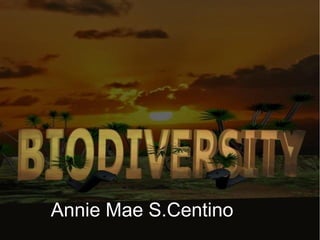
Biodiversity
- 1. Annie Mae S.CentinoAnnie Mae S.Centino
- 2. Why is Biodiversity important? All species are interconnected. They depend on one another. With less biodiversity, these connections weaken and sometimes break, harming all the species in the ecosystem. Biodiversity is important to people in many ways As biodiversity decreases, these systems break down.
- 3. Conserving the Biodiversity The best way to conserve biodiversity is to save habitats and ecosystems rather than trying to save a single species.
- 4. Biodiversity is usually explored at three levels - genetic diversity, species diversity and ecosystem diversity. These three levels work together to create the complexity of life on Earth.
- 5. Genetic Biodiversity Genetic diversity is the variety of genes within a species. Each species is made up of individuals that have their own particular genetic composition. This means a species may hae different populations, each having different genetic compositions -Genetic diversity is the variety present at the level of genes. Genes, made of DNA , are the building blocks that determine how an organism will develop and what its traits and abilities will be. This level of diversity can differ by alleles by entire genes or by units larger than genes such as chromosomal structure.
- 6. Genes
- 7. Why is it important? The amount of diversity at the genetic level is important because it represents the raw material for evolution and adaptation. More genetic diversity in a species or population means a greater ability for some of the individuals in it to adapt to changes in the environment. Less diversity leads to uniformity, which is a problem in the long term, as it is unlikely that any individual in the population would be able to adapt to changing conditions As an example, modern agricultural practices use monocultures, which are large cultures of genetically identical plants. This is an advantage when is comes to growing and harvesting crops, but can be a problem when a disease or parasite attacks the field, as every plant in the field will be susceptible. Monocultures are also unable to deal well with changing conditions.
- 10. Species Diversity Biodiversity studies typically focus on species. They do so not because species diversity is more important than the other two types, but because species diversity is easier to work with. Species are relatively easy to identify by eye in the field, Where as genetic diversity requires laboratories, time and resources to identify and ecosystem diversity many complex measurements to be taken over a long period of time. Species are also easier to conceptualize and have been the basis of much of the evolutionary and ecological research that biodiversity draws on. Species are well known and are distinct units of diversity. Each species can be considered to have a particular "role" in the ecosystem, so the addition or loss of single species may have consequences for the system as a whole. Conservation efforts often begin with the recognition that a species is endangered in some way, and a change in the number of species in an ecosystem is a readily obtainable and easily comprehensible measure of how healthy the ecosystem is.
- 13. -The term "ecosystem" represents all levels greater than species: associations, communities, ecosystems, and the like. Different names are used for this level and it is sometimes divided into several different levels, such as community and ecosystem levels; all these levels are included in this overview. This is the least-understood level of the three described here due to the complexity o the interactions. Trying to understand all the species in an ecosystem and how they affect each other and their surroundings while at the same time being affected themselves, is extremely complex. Populations and non-living environmental components- such as water or minerals surrounding them interact dynamically to form an ecosystem. Ecosystem diversity is the variety of ecosystems in a given place. An ecosystem is a community of organisms and their physical environment interacting together.An ecosystem can cover a large area, such as a whole forest, or a small area, such as a pond.